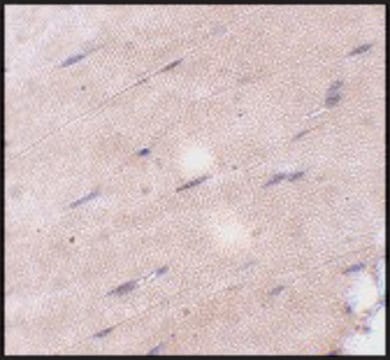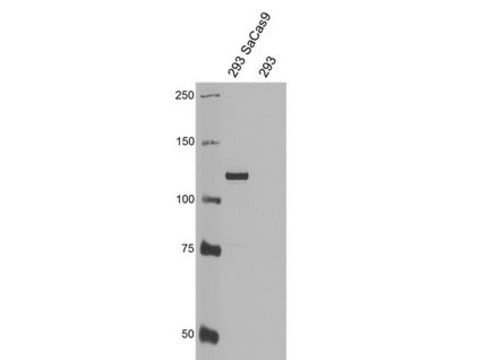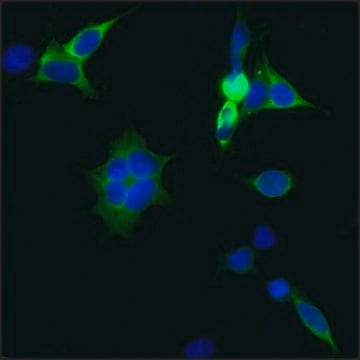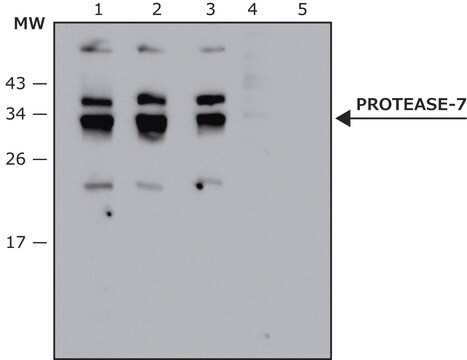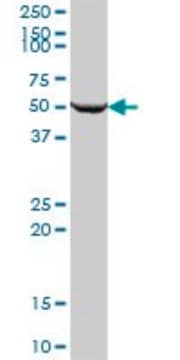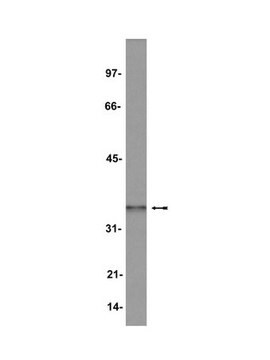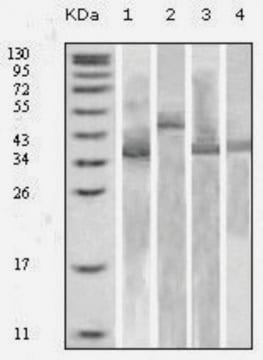SAB4200756
Anti-AsCas12a (Cpf1) antibody, Mouse monoclonal
clone AsCpf-11, purified from hybridoma cell culture
Synonym(s):
Anti-AsCpf1 antibody, Mouse monoclonal, Anti-CRISPR-associated endonuclease AsCas12a from Acidaminococcus sp. (strain BV3L6)
About This Item
Recommended Products
biological source
mouse
Quality Level
antibody form
purified from hybridoma cell culture
antibody product type
primary antibodies
clone
AsCpf-11, monoclonal
form
buffered aqueous solution
mol wt
~135 kDa
concentration
~1.0 mg/mL
technique(s)
immunoblotting: 1.25-2.5 μg/mL using purified recombinant AsCpf1 produced in E. coli
immunofluorescence: 1.25-2.5 μg/mL using human HEK-293T cells over-expressing AsCpf1 protein
immunoprecipitation (IP): 2.5-5 μg/test using lysate of human HEK-293T cells over-expressing AsCpf1 protein
isotype
IgG2a
UniProt accession no.
shipped in
dry ice
storage temp.
−20°C
target post-translational modification
unmodified
General description
Cpf1 (CRISPR from Prevotella and Francisella 1) belongs to Class-2 type V CRISPR-Cas endonuclease system.4-5 Cpf1 comprise several differences from Cas9 protein including cleavage with 5′overhangs, a shorter guide RNA and a longer distance between the seed sequence and the cleavage site.
AsCpf1, Cpf1 from Acidaminococcus sp. (strain BV3L6), was examined together with 15 members of Cpf1 nuclease family and shown to mediate efficient genome editing in HEK293FT cells with an improved results compared to SpCas9.5 AsCpf1 crystal structure in a complex with crRNA and partially duplexed target DNA, shows that AsCpf1 acts as a monomer thus identifying a unique mechanism employed by AsCpf1 for target recognition.
Immunogen
Application
- immunoblotting (~135 kDa),
- immunofluorescence
- immunoprecipitation
Monoclonal anti-AsCpf1 antibody can provide a useful tool for genome editing research such as detecting and monitoring AsCpf1 positively transfected cells.
Physical form
Storage and Stability
Other Notes
In order to obtain best results in different techniques and preparations we recommend determining optimal working concentration by titration test.
Not finding the right product?
Try our Product Selector Tool.
Storage Class Code
10 - Combustible liquids
Flash Point(F)
Not applicable
Flash Point(C)
Not applicable
Certificates of Analysis (COA)
Search for Certificates of Analysis (COA) by entering the products Lot/Batch Number. Lot and Batch Numbers can be found on a product’s label following the words ‘Lot’ or ‘Batch’.
Already Own This Product?
Find documentation for the products that you have recently purchased in the Document Library.
Our team of scientists has experience in all areas of research including Life Science, Material Science, Chemical Synthesis, Chromatography, Analytical and many others.
Contact Technical Service